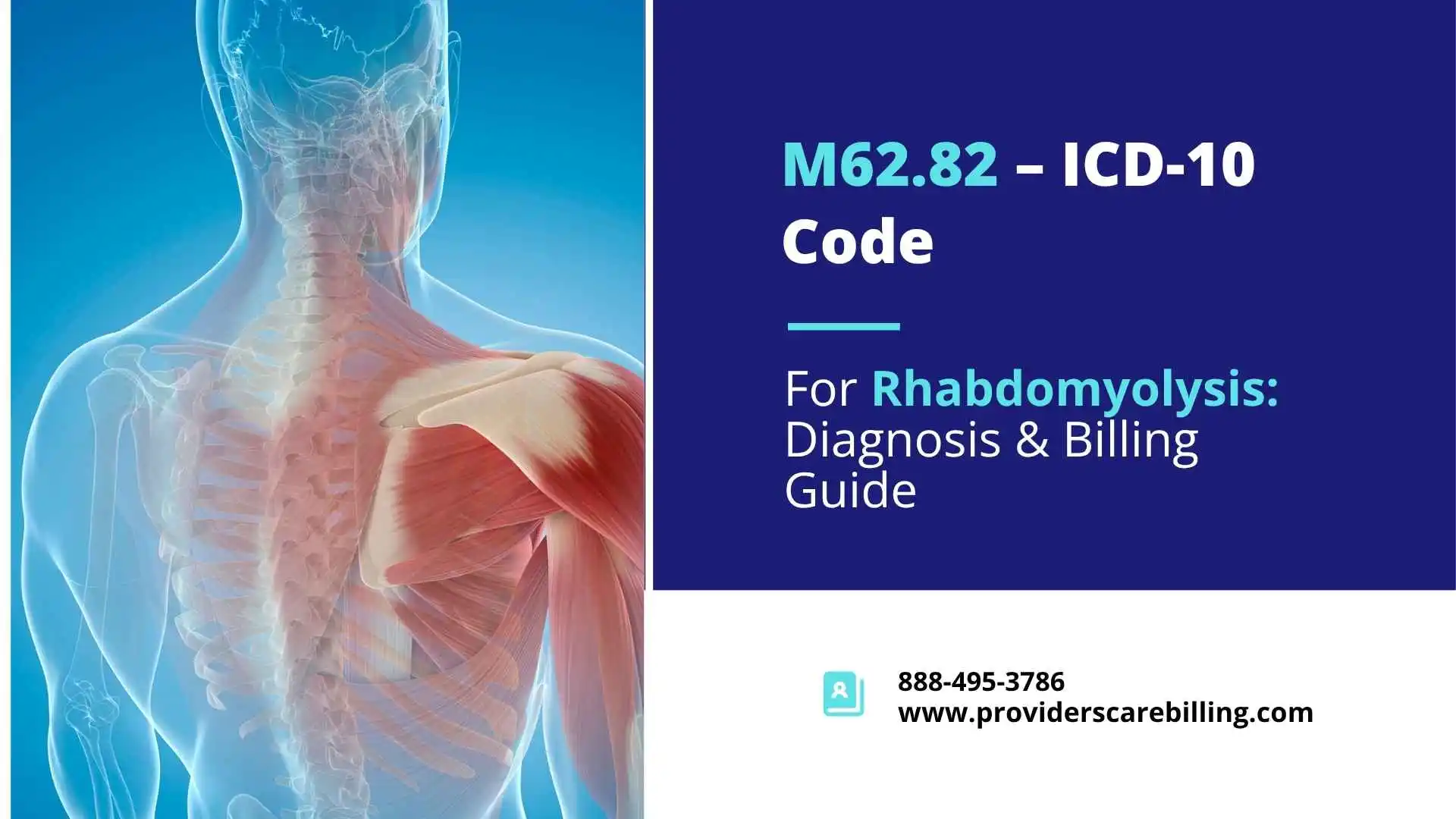Rhabdomyolysis is a serious condition. It can happen to anyone. The intense exercise, accidents, and some types of medication can initiate this disorder. Proper diagnosis and treatment are needed immediately in order to mitigate further damage to the human body. This is where the ICD-10 code for rhabdomyolysis M62.82 comes into play.
In this post, we will cover the definition of rhabdomyolysis, its impact on bodily systems, an explanation of what the code M62.82 signifies, and how practitioners apply it in their work. In addition, we will tackle other codes such as M62.81, differentiate between traumatic vs non-traumatic rhabdomyolysis ICD-10 codes, along with answering frequently asked questions about coding muscle weakness.
Let’s see the further details and make sense of these codes simply and clearly!
What is Rhabdomyolysis?
The muscle breakdown happens too quickly in the body. It happened due to myoglobin being released into the bloodstream during fibrous tissue damage, which can be toxic to the kidneys. It is dangerous, especially if left untreated. This condition can potentially progress toward kidney failure.
Some of the most common medical triggers include:
- Excessive Strain or Workout
- Sustained injuries
- Specific and different pharmaceutical treatments
- Intense dehydration
- Long-term infection
The following are additional detrimental symptoms:
- Fatigue
- Cognitive fog
- Increased body temperature
- muscle fatigue
- fever
It is very important to diagnose rhabdomyolysis early. After knowing you can start the treatment as soon as possible for your health.
What is the ICD-10 Code for Rhabdomyolysis?
The specific code ICD-10-CM Code for Rhabdomyolysis is M62.82. This is the code that is used by the provider and insurance company. They are recording a diagnosis of rhabdomyolysis.
ICD-10, or ‘International Classification of Diseases, Tenth Revision,’ is an international system for billing, record keeping, and research purposes in any given area. Every medical condition has a corresponding code.
When physicians use this particular code, they communicate with other professionals. Both within the organization and with outside providers. The health plan that covers the patient’s care has diagnosed the patient with rhabdomyolysis.
What Does M62.82 Mean?
In ICD-10:
- M refers to the Musculoskeletal system and connective tissue, a major diagnostic category.
- 62 Other disorders of muscle
- 82 relates specifically to rhabdomyolysis.
Hence, M62.82 applies to all patients who are diagnosed with rhabdomyolysis.
Understanding Non-Traumatic Rhabdomyolysis ICD-10
There are many cases where rhabdomyolysis occurs without any form of injury. There are such cases that are termed non-traumatic rhabdomyolysis. These are caused by factors like:
- Acute infections
- Certain medications, such as statins
- Consumption of drugs
- Genetic traits
The non-traumatic rhabdomyolysis still retains the ICD-10 code M62.82 assigned to it. The additional codes may be added to explain the underlying cause. For example, if a drug caused it, the doctor may also include a code related to drug-induced muscle damage.
What is Traumatic Rhabdomyolysis ICD-10?
The traumatic rhabdomyolysis occurs due to specific physical injuries. It happens particularly with crush injuries or accidents involving muscle damage. The ICD-10 code for traumatic rhabdomyolysis remains M62.82 even in these cases. The physicians can still choose to include other codes for the patient. This practice aids in capturing a comprehensive picture of the patient’s condition.
The M62.82 is primarily considered the rhabdomyolysis code. It is also supplementary codes that capture additional details concerning its causation, be it traumatic factors or non-traumatic components.
M62.81 Diagnosis Code vs M62.82
The other code you may come across is M62.81. It may pertain to generalized muscle weakness. So what’s the difference between them?
- M62.81 diagnosis code: Without rhabdomyolysis, this code captures the instances when a patient presents with generalized muscle weakness.
- M62.82: It belongs to cases where there is muscle breakdown through damaging processes known as rhabdomyolysis.
If a patient simultaneously manifests muscle weakness alongside other symptoms of rhabdomyolysis, both codes may be employed together by the physician. They represent different concepts: weakness versus breakdown.
ICD-10 Code for Bilateral Lower Extremity Weakness
It is important to document both legs to classify bilateral weakness. The ICD-10 code for bilateral lower extremity weakness does not exist as a singular unified code. It appears clinicians would subdivide the diagnosis into:
- M62.81 for generalized muscle atrophy
- R53.1 for lethargy and anergia
- With possible additional codes indicating involvement of the limbs.
- Additional details need to be provided regarding the contextual reasoning behind
The exact coding depends on the cause of the weakness and what the doctor finds in the physical exam.
How Is Rhabdomyolysis Diagnosed?
Physicians utilize various tests to confirm a diagnosis of rhabdomyolysis. The first and most vital is the blood test for creatine kinase (CK) levels. Elevated muscle breakdown is evidenced by increased CK levels.
- Other relevant tests may consist of
- Urinalysis (for myoglobin)
- Tests for renal function
- Electrolytes
- In some situations, imaging studies
Myoglobinuria can be identified by urine tests. They are assessing kidney function and electrolytes. In certain instances, conducting image examinations helps evaluate kidney health. After providing a diagnosis, treatment often starts with replenishing fluids intravenously to aid in toxin removal from the kidneys.
Since rhabdomyolysis can sometimes occur as a complication in patients with severe gastrointestinal issues, it’s also important to understand the billing process for ICD-10 Code K21.9 – GERD.
In other situations, some additional treatments will be necessary to alleviate pain. They manage electrolytic balance as well as renal functions.
Why is Correct Coding So Important?
The application of ICD codes for rhabdomyolysis is important for multiple reasons, such as:
- It facilitates the meaningful exchanges between physicians and nurses.
- Safeguarding proper medical evaluation
- Informing insurance providers about services that require coverage.
- Accurate reporting supports credibility when studying healthcare systems.
The pointed focus through using M62.82 enhances directed surveillance of incidences associated with rhabdomyolysis, their causes, and frequency, thus enabling a greater understanding of this condition’s pathophysiology.
Real-Life Examples of When M62.82 Might Be Used
Consider a scenario where an athlete presented to the emergency room complaining about significant muscular discomfort after intense exercise. He demonstrates weakness coupled with darkened urine as well as marked muscle fatigue.
The physician checks his CK levels, confirming a significant rise, indicating mk not only overexertion but dehydration too–thus he diagnoses him with rhabdomyolysis using code M62.82.
Let us consider another case: a construction worker gets trapped under debris during an accident. His legs are badly injured, and lab tests confirm rhabdomyolysis. The code M62.82 is used with additional trauma codes.
Conclusion
Rhabdomyolysis is a serious condition that needs immediate medical care. The muscle breakdown can lead to real damage, especially to the kidneys. It happens for many reasons, no matter whether it’s from an injury, an extreme workout, or medication.
Using the accurate rhabdomyolysis ICD-10 code, M62.82, is so important. It makes sure the patients get the right help quickly. And ensure that healthcare systems record and treat the condition correctly and accordingly.
It also helps to distinguish between non-traumatic rhabdomyolysis ICD-10 cases and traumatic rhabdomyolysis ICD-10 events. When a patient only has muscle weakness, then the M62.81 diagnosis code or other related codes can be used.
Accurate coding not only supports treatment but also saves lives. The M62.82 is important in the world of diagnosis and care, whether you’re a healthcare provider, student, or curious patient.




